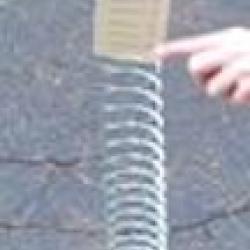Source Institutions
Source Institutions
Add to list Go to activity
Activity link broken? See if it's at the internet archive

In this activity, learners explore how spring scales work and how they are used for non-exact weight measurement. Learners work in teams to develop their own working spring scale out of ordinary items. They test their scale, present their designs to the group, compare their designs with those of other teams, and reflect on the experience.
- Under 5 minutes
- 1 to 2 hours
- $10 - $20 per group of students
- Ages 8 - 18
- Activity, Experiment/Lab Activity, Lesson/Lesson Plan
- English
Quick Guide
Materials List (per group of students)
- Student Resource Sheets
- Student Worksheets
- A set of identical items to be weighed (i.e. golf ball, tennis ball, cup of matching coins, or weights)
- A spring (slinky or spring ordered from a scientific supply company)
- Cardboard
- Wooden dowels
- Tape
- Foil
- Construction paper
- Glue
- Markers
- String
- Rubber bands
- Wire
- Popsicle sticks
- Paper cups
- Straws
- Pipe cleaners
- Paper clips
- Screen
- Small plastic or PVC piping
Subjects
-
Engineering and Technology
-
Engineering
- Mechanical Engineering
-
Technology
- Construction
-
Engineering
-
Mathematics
-
Measurement
- Units of Measurement
- Size and Scale
-
Measurement
-
Physical Sciences
-
Motion and Forces
- Gravity
-
Structure and Properties of Matter
- Mass and Weight
-
Motion and Forces
-
The Nature of Technology
-
The Design Process
- Research and Development
- Invention and Innovation
- Problem Solving
- Troubleshooting and Maintenance
-
The Design Process
Audience
To use this activity, learners need to:
- see
- read
- touch
Learning styles supported:
- Involves teamwork and communication skills
- Involves hands-on or lab activities
Other
Components that are part of this resource:
Includes alignment to state and/or national standards:
This resource is part of:
Access Rights:
- Free access
By:
Rights:
- All rights reserved, IEEE,
